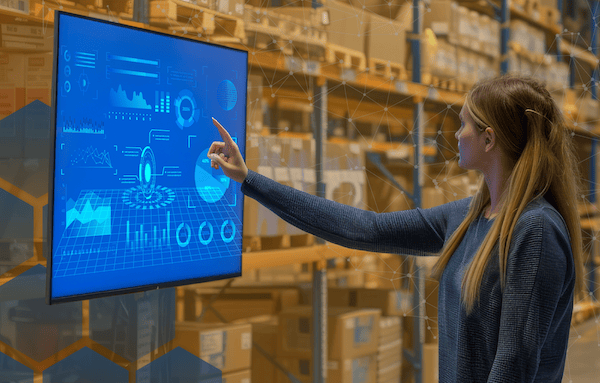- Warehouse Wisdom. Weekly.
- Posts
- Warehouse Wisdom. Weekly. 01/31/2025
Warehouse Wisdom. Weekly. 01/31/2025
Only the most relevant news for SMBs to improve logistics – picked, packed, and delivered without the bias.

Happy Friday!
It’s been another whirlwind week in logistics where we saw The U.S. President threatened tariffs on Columbia after the South American country’s President barred two military planes carrying deported Colombians from the US from landing, only to end with a crisis being averted…well, except for one minor detail (Arabica coffee prices have hit new highs). Meanwhile, U.S. ports are making history and giving us a good note to end the week on, setting new freight records despite persistent challenges.
In this week’s newsletter, we’re covering North American trade relations potentially hitting a snag on February 1st, UPS further distancing itself from Amazon, OpenAI’s Operator shaking up online shopping, Walmart making a big bet on Canada, and more. And, for the sake of all caffeine-dependent supply chain professionals out there, we’re hoping that our morning brew doesn’t become a luxury import. Let’s dive in…
Global Freight and Logistics
North American supply chains brace for impact

The North American trade landscape could be in for a shake-up as early as February 1st, with the possibility of 25% tariffs on Canada and Mexico. If these tariffs go into effect, expect a ripple effect across supply chains, pricing, and the collective stress levels of logistics professionals everywhere.
Meanwhile, the U.S. is eyeing potential fines against Panama over no-bid contracts that seem to be favoring China. Stay tuned to see whether Washington follows through or if this remains just another round of diplomatic posturing.
Maersk has made it clear it won’t be returning to the Red Sea just yet, which is bad news for global shipping efficiency but great news for alternative routing strategies. With tensions in the Red Sea still high, carriers continue to reroute vessels, adding transit times and costs that inevitably trickle down to shippers and consumers.
And speaking of added costs, smaller U.S. e-commerce retailers are feeling the squeeze as the government tightens tariff exemptions, forcing them to navigate higher import duties that were once avoidable. It’s just another week in logistics—where adaptation isn’t optional, it’s the entire business model.
There’s a reason 400,000 professionals read this daily.
Join The AI Report, trusted by 400,000+ professionals at Google, Microsoft, and OpenAI. Get daily insights, tools, and strategies to master practical AI skills that drive results.
U.S. and Canadian Freight
UPS cuts ties, freight costs shift, and Canada Post gets a lifeline

UPS is officially cutting its Amazon volume by more than 50% to boost package profitability—because delivering millions of boxes for razor-thin margins isn’t a sustainable business model. While Amazon will undoubtedly find another way to keep its packages moving, this shift marks another chapter in the ongoing logistics divorce between the two giants. For UPS, it’s a strategic pivot toward higher-margin shipments, but for the rest of us, it’s a reminder that even in logistics, sometimes breaking up is the best financial decision.
Meanwhile, the NMFTA is preparing to roll out proposed freight classification changes, so it’s time for shippers to brace for impact. If history is any guide, some commodities will see cost increases, others might get slight breaks, and everyone must decipher the latest version of the classification rulebook.
North of the border, Canada Post is tapping into emergency financing to avoid insolvency, proving again that the postal business is no easy game. Despite handling an increasing number of parcels, the organization continues to struggle under financial pressures, leading the government to step in with a cash injection. And speaking of price adjustments, UPS SurePost changes are starting to take effect, meaning shippers relying on the budget-friendly option might need to re-evaluate costs.
Logistics Vitals
Small parcel carriers struggle to deliver on time in peak season

During the 2024 peak season, major small parcel carriers faced notable struggles with on-time performance, proving that the most wonderful time of the year is also the most challenging for logistics. Despite years of experience handling holiday surges, delays crept in, making some deliveries feel more like a New Year’s surprise than a Christmas present. Key data points include:
UPS led the pack with an on-time performance rate of 96.5%, but still saw a slight decline from previous years.
FedEx followed closely behind at 91.8%, with performance dipping as volume surged.
USPS lagged with an 90.4% on-time rate, as network congestion and weather disruptions took a toll.
Overall, carrier performance slipped compared to 2023, despite efforts to optimize delivery networks.
Marketplaces
AI shopping assistants, steady sales growth, and Walmart’s big bet

AI-powered shopping assistants are officially here, and OpenAI’s Operator is leading the charge. Designed to revolutionize e-commerce, this AI agent aims to help customers find products faster, streamline checkout, and potentially reduce the number of rage-inducing abandoned carts. For online retailers, this means it’s time to start getting familiar with AI-driven shopping experiences—because if you’re not integrating AI into your business strategy, you might as well be selling through fax orders.
Not to be outdone, Alibaba is rolling out its own AI shopping assistant, ensuring that the race to dominate AI-driven retail is officially a global competition. While OpenAI is focusing on Western markets, Alibaba’s tool will reshape how consumers shop in China and beyond, making personalized recommendations, handling transactions, and probably upselling you things you didn’t know you needed.
Meanwhile, U.S. retail sales are projected to grow 4% in 2025, a solid increase that suggests consumers are still spending, despite economic uncertainties.
And Walmart Canada is making sure they’re ready to capture those dollars, pouring billions into new stores and supply chain upgrades. This investment signals confidence in retail’s future and reinforces the fact that, while AI might be changing how we shop, logistics and fulfillment remain the backbone of the entire operation.
Warehouse Tech
Robots on the road and drones in the sky, but automation hype is cooling off

Kodiak Robotics has taken autonomous trucking a step further, with driverless trucks now hauling frac sand across private desert roads in Texas and New Mexico. If you’re going to let robot trucks roam free, a vast, empty desert seems like the safest place to do it. For now, these fully autonomous runs are limited to private roads, but it’s another signal that the industry is moving closer to large-scale adoption. Whether the rest of the supply chain is ready is another question entirely.
Amazon is inching closer to launching drone deliveries in the U.K. The question remains whether these drones can handle Britain’s notoriously unpredictable weather—because last we checked, rain and high winds weren’t exactly drone-friendly. But if Amazon can iron out the glitches, the U.K. could become a proving ground for drone deliveries at scale, potentially giving the company a leg up in the race to make airborne logistics a reality.
That said, robot hype seems to be cooling off, with some businesses scaling back on automation investments as they realize that, surprise, robots still require a lot of operational fine-tuning. While automation is here to stay, the early excitement around warehouse and logistics robots is giving way to a more measured approach.
Warehouse Quick Deliveries
Rail strikes averted in Canada, while Feds crack down on counterfeits in Long Beach
“Our collaboration with OpenAI will introduce a new paradigm of discovery and shopping online, giving more buyers exposure to eBay’s unique inventory.”

